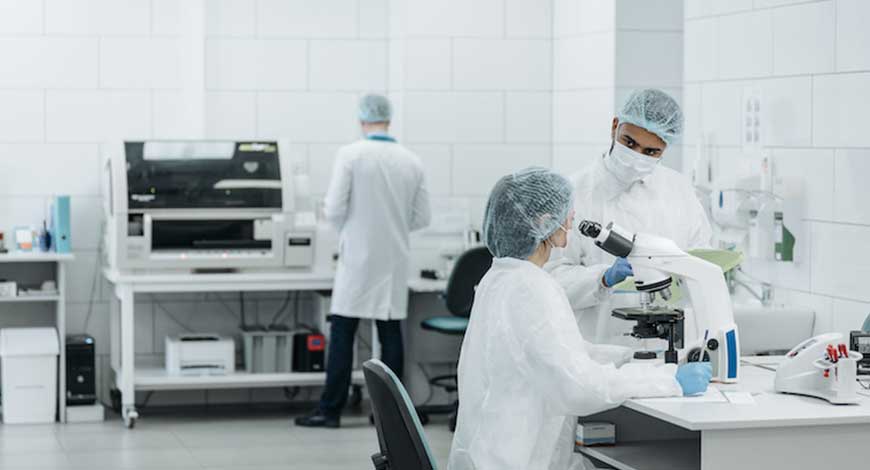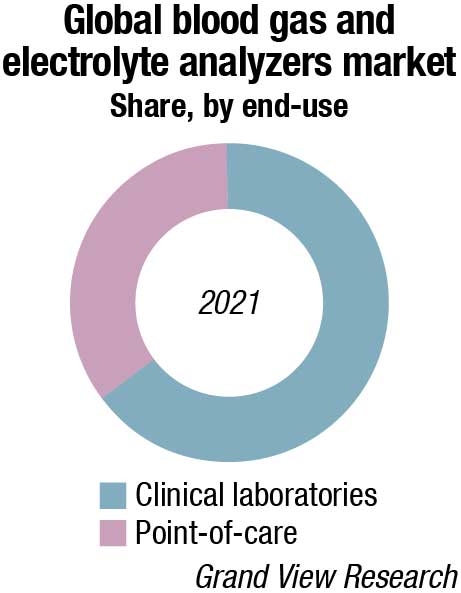Blood Gas Electrolyte
High throughput and integrated systems are gaining traction

The market is witnessing significant increase in the demand for high-throughput and integrated systems that are capable of integrating with EMRs/EHRs, enabling high efficiency and workflow.
The analyzers are important in the critical care units to determine blood gas, pH, electrolytes, and some metabolites in the whole-blood specimen. The technological advancement in the past decade has significantly improved the method of diagnosis and treatment in the healthcare facilities. The recent advances have enabled clinicians to direct therapy and improve patient outcomes.
Modern analyzers come in a variety of sizes from hand-held to portable desktop systems, which are more user-friendly, more automated, and require less technical expertise and maintenance by the end-user, compared with earlier analyzers.
The current new analyzers are typical instruments for point-of-care (POC) testing and are being installed in emergency treatment facilities and can rapidly evaluate multiple items. PoC analyzers combine increased accessibility and cost-effectiveness, with reduced maintenance requirements compared with more traditional benchtop analyzers, facilitating their increasing use in routine perioperative and intensive care settings.
PoC blood gas and electrolyte analyzers also facilitate analysis of the blood sample near the bedside (and especially in the delivery room), which results in accelerated clinical decision making versus that in the hospital central laboratory. Arterial, venous, and capillary blood gas samples can now be analyzed in the NICU, reducing pre- and post-sample collection errors and reducing time to results.
The oxygen saturation of hemoglobin calculation fails to account for dyshemoglobins. A co-oximeter is preferable in this instance as it can directly measure different hemoglobin species. For this reason, most modern blood gas analyzers also incorporate a co-oximeter.
Introduction of innovative technologies in combination analyzers has led to drastic evolution of blood gas and electrolyte measurement and analysis, and has also allowed the advent of hybrid, portable analyzers. Latest technologies incorporated in these systems also facilitate the introduction of blood analysis with the smallest possible quantity of blood sample.
The market is also witnessing introduction of analyzers that are compact in nature, and offer more sensitive test results, along with increasing multi-parameter monitoring capabilities. Recently, there has also been a significant increase in the demand for high-throughput and integrated systems that are capable of integrating with EMRs/EHRs, enabling high efficiency and workflow.
India is one of the fastest-growing markets in the APAC region and is expected to grow at a CAGR of 10.5 percent from 2021 to 2028, attributed to rise in awareness regarding diagnosis of asthma, and other respiratory disorders. The country has faced a challenge of air pollution, leading to high prevalence rate of respiratory diseases.
The increasing prevalence of diseases and alarming loss of human capital due to aging population has also raised serious health concerns across the nation. Obesity is also a prime predisposing factor for cardiovascular diseases, arthritis, and diabetes, among others.
Hence, the government is encouraging innovation in medical technology to curb this crisis. Shortage of technical expertise in the country to operate the analyzers, and huge maintenance costs, has led to increase in adoption of automated and self-contained analyzers.
The global blood gas and electrolyte analyzers market is expected to grow from USD 2.84 billion in 2021 to USD 2.98 billion in 2022 at a compound annual growth rate (CAGR) of 5 percent. The blood gas and electrolyte analyzers market is estimated to grow to USD 3.75 billion in 2026 at a CAGR of 5.9 percent. Blood gas and electrolyte analyzers are used to measure different parameters from whole-blood samples, such as arterial gases, including oxygen (pO2), carbon dioxide (pCO2), pH, electrolytes, and metabolites. The pH value of blood and serum or plasma is an indicator of the balance between the blood, kidney, and respiratory systems, whereas the pCO2 value of arterial blood is used to assess efficient elimination of carbon dioxide from the body, a byproduct of metabolism; and the pO2 value of arterial blood is a measure of oxygen absorbance by the body in lungs.

Electrolytes and metabolites provide additional information about the body’s metabolism. These analyzers measure ion concentrations, including potassium, sodium, bicarbonate, chloride, calcium, glucose, lactate, and magnesium from the blood. This blood sample analysis aids in the detection of medical conditions, such as kidney failure, heart failure, uncontrolled diabetes, hemorrhage, chemical poisoning, a drug overdose, shock, asthma, and chronic obstructive pulmonary disease (COPD).
The growth of the blood gas and electrolyte analyzers market is majorly driven due to rise in prevalence of chronic disorders, rise in global geriatric population, increase in the number of patients treated in ICUs, NICUs, and emergency departments, technological advancements in blood gas and electrolyte analyzers, and increase in the number of product approvals globally.
The increase in the number of patients led to more blood sample testing, contributing to the growth of the blood gas and electrolyte analyzers market. Blood tests are used for a variety of purposes, including determining cholesterol and blood glucose levels. These can help keep track of the risk of heart disease, vascular disease, and diabetes, as well as how well the problem is treated.
For instance, in 2021, of the 118.5 million blood donations received worldwide, 40 percent were collected in high-income countries, which account for 16 percent of the global population. Children under the age of five years receive up to 54 percent of blood transfusions in low-income nations, but in high-income countries, the most frequently transfused patient group is over 60 years old, accounting for up to 75 percent of all transfusions. Thus, the increase in the number of patients led to more blood sample testing, contributing to the growth of the blood gas and electrolyte analyzers market.
Blood gas and electrolytes – Technology trends
 Sanjay Patwardhan
Sanjay Patwardhan
General Manager – Sales & Marketing,
Biogeny Diagnostics Pvt. Ltd. (A Beacon Group Company)
Blood gas and electrolyte analyzers are used to measure different parameters from biological samples, such as electrolytes, metabolites, pH, blood gas, including SpCO2 and SpO2. These analyzers are easy-to-use, effective, and give assured results in less time. The devices have evolved significantly over the years and are now widely used in intensive care units, emergency services, and routine diagnostic services.
Conventionally used standalone analyzers are rapidly being replaced by the improved portable and combination analyzers. The overall development rate for combination analyzers is high. However, since they come with shorter PLC, it demands for higher rate of continuous product improvements.
The major factors that contribute to growth of this market are increase in the number of patients in ICU, NICU, and emergency departments. The recent pandemic also positively impacted this market segment.
From the age-old table-top and bench-top models, the blood gas and electrolyte analyzers have drastically changed in modern times to cope with the requirements like speed of analysis, offering multiple clinically important parameters at a time, and using less space for installation. From simple POCT devices to the ultramodern devices, incorporating smartcard, microfluidics, and use of IoT facilities are becoming the keys for growth of this segment.
Electrolyte analysis is traditionally a part of biochemistry, which is usually performed by using techniques like photometry and ISE. ISE technology has specific advantages like quick results, higher measuring range, and less sample volume requirements. Instruments incorporating latest technologies are gaining popularity to make the system easily adoptable at laboratory level.
Beacon Group has introduced two latest technologies in electrolyte analyzers, in which the conventional analyzer with ISE incorporates features like long-life maintenance-free electrodes, facilities for daily shut down, and multiple calibration options, which make the electrolyte analysis simple and user friendly.
In addition to this, Beacon also offers the system, which uses the multi-biosensor module technology, incorporating microfluidics to keep the system free from problems like frequent deproteinization, liquid path blockage, or air leakage. Also, the system uses less volume of sample to generate more accurate and precise results in a shorter time.
In addition, the integration of blood gas analyzers with electronic medical records and laboratory information systems offer a lucrative opportunity for market expansion. These integrated systems not only allow for accurate monitoring of patient’s health, but they also help to streamline workflow. Moreover, the rise in demand for technology-integrated combined systems and POC devices is expected to significantly boost the blood gas and electrolyte analyzers market during the forecast periods.
Furthermore, the availability of various portable, benchtop easy-to-use, with higher accuracy and rapid devices, increase in various initiatives and strategies by the government, and the key players of the market play a pivotal role in increasing awareness for diagnosis, which further boosts the blood gas and electrolyte analyzers market growth.
Considerable rise in healthcare expenditure globally has further fueled the market. The major factors that are responsible for the increase in healthcare expenditure are rise in population, especially geriatric, and increase in medical service utilization. However, high cost of analyzers and complexity involved in the interpretation of blood analysis data are expected to impede the blood gas and electrolyte analyzers market growth.
On the basis of product type, the consumables segment dominated the blood gas and electrolyte analyzers market in 2021, and is expected to continue this trend in coming years owing to the increase in the number of patients suffering from chronic diseases, which increases the number of blood gas tests performed. This further leads to increase in the demand for consumables.
On the basis of end-user, the hospitals segment dominated the market in 2021, and is expected to continue this trend over the next 8 years owing to surge in hospitalization of patients as most of the critical care patients are treated in hospitals.
The blood gas and electrolyte analyzers market in the US is estimated at USD 223.1 million in the year 2021. This is attributed to increase in the adoption of technologically advanced portable analyzers and combined blood gas and electrolyte analyzers in the hospitals, clinics, and emergency departments, presence of key players, and rise in the healthcare expenditure in the region.
Europe blood gas and electrolyte analyzers market is projected to account for a notable market share over the next 8 years, and this is expected to be driven by the rising aging population in this region along with the growing prevalence of chronic diseases. The rising use of POC diagnostics is also expected to favor the blood gas and electrolyte analyzers market growth in this region through 2030.
Overcoming challenges in electrolytic analysis
 Sourav Saha
Sourav Saha
Product Manager – Critical Care,
Transasia Bio-Medicals Ltd.
Electrolyte analyzers are routinely used in medical diagnostics to examine physiological conditions within the body. Hospitals and clinical laboratories, as well as treatment sites, rely on electrolyte analyzers to measure the concentration of different ions in the blood, providing important information about the body’s electrolyte balance that can be used to detect metabolic imbalances, kidney and heart disease, and contribute to the early detection of human diseases. However, despite their widespread use, electrolyte analyzers operating with traditional technology are subject to a multitude of challenges, with the need for periodic replacement of electrodes, in particular.
Analysis of electrolytes
In the last 20 years, electrolyte analysis in clinical laboratories, using biological samples, including serum, whole blood, urine, and others, has been based mainly on electrochemical measurements, using conventional flow through electrode technology. Unfortunately, this technology requires periodic maintenance and can give erroneous results if not replaced frequently, which in turn disrupts workflows and can be costly for laboratories. As a result, this can increase hands-on time for clinicians and, more importantly, overall wait time for patients.
Introduction of maintenance-free biosensor technology
In an ideal world, clinicians and medical professionals would have a stable analyzer that could be used flawlessly in everyday life. The next-generation electrolyte analyzer that has been recently launched combines maintenance-free biosensor technology with an easy-to-use interface, advanced data management, and excellent accuracy.
The integrated polymer sensor cartridge together with its long life makes this instrument a laboratorian’s dream. The analyzer is very easy to use and its built-in software helps the analyzer to fit into any clinical laboratory, and is capable of measuring the concentrations of free sodium (Na+), potassium (K+), and chloride (Cl−) from different sample types.
The all-in-one cartridge, integrated with solution and biosensor, is available in four different sizes, i.e., extra small, small, medium, and large, and is commensurate with different workloads.
The road ahead
Biosensor technology is turning out to be a cost-effective solution for electrolyte analysis. Further, enhanced healthcare infrastructure and rapidly advancing technical breakthroughs will continue to drive the electrolyte analyzer market in India.
Germany, Italy, Spain, France, and the United Kingdom are expected to be prime markets that blood gas and electrolyte analyzer manufacturers will focus on over the years to come.
The increasing aging population in Japan is expected to make it a lucrative market for blood gas and electrolyte analyzers.
China, the world’s second-largest economy, is forecast to reach a projected market size of USD 111.7 million by the year 2026, trailing a CAGR of 6.5 percent. However, Asia-Pacific is anticipated to witness notable growth, owing to increase in geriatric population, unmet medical demands, and increase in investments in the healthcare sector in the region. Moreover, India is expected to grow at a high CAGR in Asia-Pacific blood gas and electrolyte analyzers market.
Blood gas and electrolyte analyzer manufacturers are expected to focus on the development and launch of new advanced products to gain a competitive edge over other market players and strengthen their market presence.
In July 2022, EDAN Instruments Inc. announced the launch of a new blood gas analysis system. i20 is a new POC fluorescence-based CO-OX blood gas and chemistry analysis solution, designed to relieve the burden from intensive care units (ICUs), operating rooms, etc.
In June 2022, Sysmex America Inc. received FDA clearance for the addition of a new feature to its N-10 automated hematology analyzer with blood bank mode. This is the first automated analyzer to be cleared for residual WBC counting.
The key players operating in the global blood gas and electrolyte analyzers market are Abbott Laboratories, Biogeny Diagnostics Pvt. Ltd. (A Beacon Group company), Danaher Corporation (Radiometer), F. Hoffmann-La Roche AG, IDEXX Laboratories, Inc. (Opti Medical Systems, Inc.), Medica Corporation, Nova Biomedical, Sensa Core Medical Instrumentation Pvt. Ltd., Siemens AG (Siemens Healthineers), Transasia Bio-Medicals Ltd. (Erba Diagnostics Mannheim Gmbh), and Werfen Science SA.
Different kinds of blood gas and electrolyte analyzers are starting to make it onto the lists of essential equipment for diagnostic centers, hospitals, and R&D facilities as they become more and more equipped with cutting-edge infrastructure and ICU-specific equipment.
Additionally, it is anticipated that applications of blood gas and electrolyte analyzers in the measurement of various elements and disease detection, such as sodium, pH, and glucose, will promote the growth of the blood gas and electrolyte analyzers industry.












